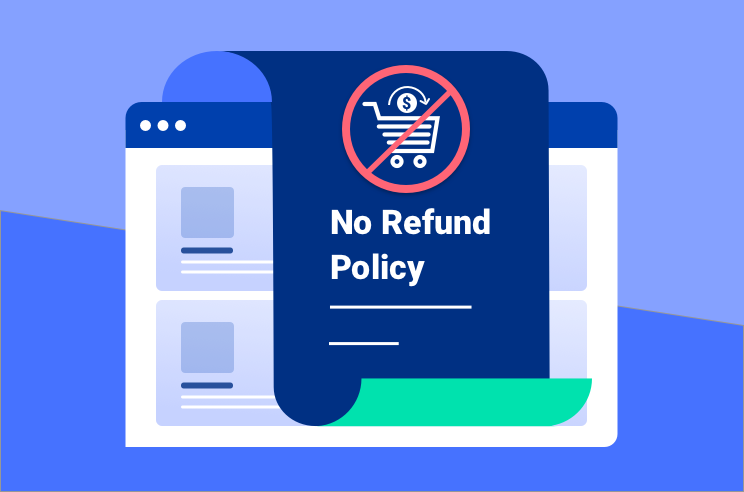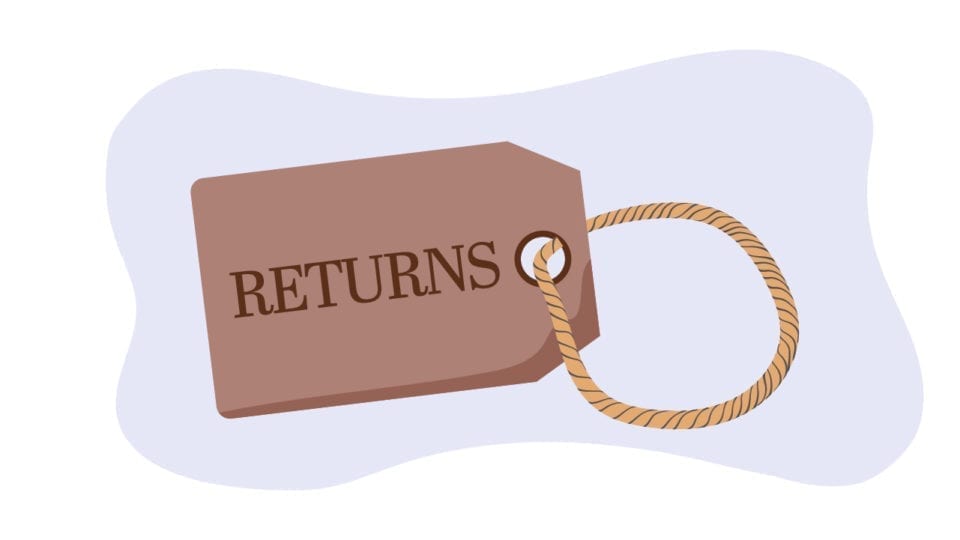In my experience, dealing with customers is the most challenging aspect of the print-on-demand services business. Changed orders, missing cartons, and returns are all too common. In print-on-demand sellers, returns may be a major headache because they eat up valuable profit margins, especially if they cannot resell the product after it has returned.
Having a robust return policy posted on your storefront is essential when dealing with print-on-demand returns in advance of the situation. Buyers will know what to expect going into the transaction, which will help prevent most returns in the first instance.
Returns management was, without a doubt, the most challenging aspect of running a print-on-demand business for myself. Take note of the use of the term WAS.
Even though it took a while, I finally recognized that I needed to have my act together regarding tax returns to avoid losing my cool in the process.
Stressing out about packages going missing in the mail was terrible enough, but it was something I couldn’t do anything about. As a result, I was determined to take action on the one aspect of my business that I could influence: the way I handled returns.
The first thing I did to alleviate my anxiety about returns and regain control was implementing a comprehensive return policy.
We must first establish what constitutes a valid return for defective merchandise before proceeding.
Dealing with Defective Products in Your Print on Demand Store
If a consumer receives a damaged, misprinted, or otherwise faulty product, it is generally assumed that your job as the seller is to refund or replace the item in question. Fortunately, most print-on-demand suppliers will replace damaged products at no additional cost if their employees caused the problem.
Customers who request a return because they received defective goods are different from customers who order a return because they received an excellent product but decided they didn’t want it anymore.
Fortunately, there is some good news a simple problem to fix. If your print provider causes the pain, most of them will send a replacement to your customer at no cost to them.
It is one of the reasons why I enjoy Printful and Printify.
The customer support provided by Printify and Printful is excellent.

Whenever a product has a flaw, they have shipped quickly and sent a replacement to the consumer. To be clear, this usually does not cover packages that have been misplaced in the mail, so you should expect to be responsible for those situations.
So, damaged merchandise does not qualify for a return. To get things started, let’s take a look at genuine returns — those instances in which customers receive the goods they ordered but decide they no longer want it.
Avoid print-on-demand returns by implementing a strict return policy
Having a clear and concise return policy listed in your store might avoid a significant number of returns before your consumers even consider submitting a request for one. Your customers’ knowledge of your return policy before purchasing can inspire them to make more informed decisions regarding their purchases.
Return policies are critical to me, so I decided to implement a rigorous one in my store. Not take refunds on items unless they are defective, ruined, or printing errors in some way.
I don’t always adhere to this stringent principle to the letter, but we’ll get into that later.
As a result of our culture with Amazon obsession, we tend to purchase products with little thought because we can return them with no difficulty. And the returns are fantastic! When I think about how many people use Amazon, I wish my print-on-demand company could handle the volume.

However, for my small POD store, this is not feasible. Said, I cannot deal with the consequences of someone ordering three different sizes of the same shirt so that they may try them all on and return the two that don’t suit them.
As a result, I inform my consumers that returns are not permitted. As a result, I receive a disproportionately large number of questions from consumers concerning sizing and fit, which I gladly address. It is a sign that my consumers take their purchases seriously and put in the necessary effort to ensure they purchase the correct item.
Important note: I am aware that I am likely losing business due to my lack of a generous return policy. A customer choosing between my store and another store that enables returns is more likely to select the other store, according to my experience.
But that’s all right with me. I want to lose a few sales rather than deal with the inventory and profit-loss difficulties of accepting returns.
You might be hesitant to have a policy as robust as mine at this point. I get what you’re saying. When creating your return policy for your shop, there are a few things to keep in mind.
No-returns policy
Despite my no returns policy, I accept returns for my print-on-demand products infrequently, but only temporarily. Generally, if I believe that I can resell the item, if I haven’t received a large number of return requests recently, or if the client is courteous about it, I will honor the return request.
To be a seller, you must first and foremost be human. The bottom line is that we want our customers to have positive experiences with our shop, and we don’t want to come across as stone-cold robots who are solely concerned with making a profit.
I’ve found that my no-return policy prevents 99 percent of return requests from being sent. It became scarce for me to receive an email from a consumer requesting a return once I put it into effect after I implemented it. As a result, I began to comply with these very few requests.

Most of the time, consumers have read my return policy and are kind in requesting an exemption. As merchants, we are all aware that a bit of politeness may go a long way.
Making exceptions like this puts all of the tension associated with processing print-on-demand returns right back to the forefront of our minds. The opposite is true: taking a more relaxed attitude to tax returns makes them SO MUCH easier.
Listed below are the reasons why:
- Your return inquiries will decrease if you have a no-returns policy. Reduced anxiety – done and dusted.
- The customer will be aware that you have a no-returns policy and that they are asking you to do them a favor if they make a return request, which will be unlikely. When you finally return your money, they will consider it to be a thoughtful gesture on your part on your behalf.
- A positive review increases the likelihood of a positive relationship between you and your customer between you and consumer. Decreased anxiety – done and dusted.
- You are effectively changing the script by enforcing a no-return policy and occasionally permitting returns as a courtesy. Accepting a return would become routine and expected if you allowed returns.
- By permitting a return even if you have a no-returns policy, you are going out of your way to circumvent your policy and make things easier for your customer, which they will be eternally grateful for.
- There is some subtle selling psychology at work here, but it is effective nonetheless. While it benefits your store, it also has a beneficial effect on the amount of stress you experience while dealing with returns.
So, whether you decide to have a strict return policy for your print-on-demand store or not, there are a few very crucial factors to take into consideration.
Make Your Printing Depend on Demand Return Policies for the Different Types of Products You Sell in Your Store
Suppose your print-on-demand products are uniquely created for each customer. For instance, you may want to consider offering a more generous return policy than you do for your other print-on-demand products that are more generic and can be resold in the future, such as promotional products.
If you sell things in your business that may customize with someone’s name, photo, or other information, you may decide that you wish to have a strict, no-returns policy with no exceptions – no exceptions.
Once a product has been tailored to meet the needs of a specific consumer, it cannot resell. Fortunately, many consumers are already aware of this and do not anticipate returning their customized things.

If an individual wishes to return one of your more generic products, you may be able to sell it again, especially if it is one of your most popular products.
Consider the types of things you sell and whether or not you can resell them multiple times. For instance, you may want to consider making your return policy more accommodating.
If you decide to allow returns, keep in mind that you will be responsible for the shipping charges.
Decide who will be responsible for return shipping for your Print on Demand products.
Decide if you will require the customer to spend the shipping expenses to return the item to you if you accept returns in your print-on-demand shop before taking any orders. Clearly stating this in your return policy and any correspondence with a client regarding a return will be necessary.
Must consider shipping expenses if you intend to accept returns, even if you do so on a limited basis or only once in a while.
These days, sending mail is not inexpensive. Accepting a return means you’ve already lost the money you spent on the product as well as any profit you gained on the transaction. If you have to pay for return postage as well, you’ll be in a lot of trouble financially.
Whenever I accept returns, I require that the purchaser cover the cost of returning the item, which has never been an issue.
You should write a script once you’ve decided on your return policy.
When you’ve decided on your return policy, write it down and post it prominently around your store so that customers can review it several times before making a purchase. In addition, write down a script that you will send to your consumers when they contact you about returns.
Immediately after determining your return policy, write it down and double-check that you have included all pertinent information.
After that, put it prominently throughout your store. Incorporate it into your shop’s announcements area, within each listing, in the shop’s description, and in the message, you send your customers to confirm their orders.
Also, prepare pre-written scripts that you may send to customers if they inquire about return policies. If you allow returns, ensure that your writing includes everything the customer needs regarding shipping charges, refunds, and other important information.
You should make sure that this script clearly explains why you do not accept returns. Make every effort to be courteous while being challenging.

Due to the existence of these scripts, you no longer have to be concerned with making decisions and composing your response for every consumer who contacts you.
This will not only save you a significant amount of time, but it will also save you a significant amount of mental energy that you might use to improve the overall quality of your store.
Returns in your print-on-demand store are never a pleasant experience. However, it can be a lot less stressful than it initially appears to be with the proper mechanisms in place. Spend a little time upfront preparing things, and you’ll save yourself a lot of headaches later on, whether you opt to accept return items or not.
How to Create a Return Policy for Your Print on Demand E-Store: The Practice of Building Trust in Your Business
As the number of people who utilize the internet continues to increase, e-commerce continues to grow. Although the global epidemic had no negative impact, people were forced to depend on digital services to supply them with the conveniences and luxuries that contemporary civilization offers due to being confined to their homes.
Despite all of the promising prospects that e-commerce businesses face, one significant roadblock that continues to stand in the way of their successful journey down the road to fortune is the cautious attitude of consumers. It is usual for individuals to feel wary about new situations about sending their money to an unknown seller. They patiently wait for what seems like an eternity until they get tangible evidence that everything is OK.
Many questions emerge in the minds of anxious consumers, making it much more difficult to relax while they’re waiting. If you are unsatisfied with the merchandise, what should you do? Is it necessary for me to cover the cost of returning the item to the manufacturer? If the order gets misplaced in transportation, what should you do? And what happens if the package is delivered to the incorrect address? Store rules for consumers are fundamental in assuaging concerns and dispelling apprehensions of such picky buyers.
When was your last company’s rules and regulations?
An important fact to remember to people are not machines and will make errors. Sellers and buyers both make mistakes in business, and these mistakes are costly to both. Whoever is to blame, the result is always the same: customer complaints and product returns. According to the National Retail Federation estimates, the typical consumer returned about 10% of their purchases in 2018. This is a summary index that includes e-commerce and storefront transactions, and for online store trade, traditional or dropshipping returns account for an incredible 30% of all returns! Because internet consumers cannot smell, feel, taste, or try on the goods before making an irreversible purchasing choice, it is no surprise that they are so reluctant.
It is only logical that more than two-thirds of consumers examine the terms and conditions of the company’s return policy before committing to a purchase in light of these statistics. In the event of a failure, they want to be sure that they will not lose a cent.

Business owners aware of this universal inclination make efforts to provide stability in their customers’ lives. Increasingly, businesses recognize that returns are the least enjoyable aspect of their business – both in terms of cash gain and emotional distress. When they learn they have failed to fulfill orders, they lose money and incur a moral repercussion. But if they fail to see the significance of this element of customer service, the ramifications may be dire.
Dissatisfied customers will begin to express their displeasure in various ways, including social media and comments on your website. When consumers use Google to look for your company, Google may eventually display negative comments. If you fail to handle the return issue, you may find yourself to be penny-wise but pound-foolish since reputational harm is the most difficult to recover from. Conversion rates and the rate of repeat purchases will both suffer as a consequence of this.
On the other hand, making every effort to satisfy customers who submit return requests will result in long-term revenue growth and client loyalty. It is well acknowledged that customers who have a positive return experience are more inclined to purchase from the same online retailer. As a result, people prefer to ignore that their purchase was a dud instead of praising the vendor’s abilities to rectify the situation.
Buyers have different reasons for returning products.
The excellent quality of the goods that your e-store offers, as well as the dedication of its employees to providing excellent customer service, are the best safeguards against returns of any kind. Although these requirements are fulfilled, returns may still occur even if none of the above criteria is satisfied. What’s the deal with that?
I placed an order for the wrong product or size. First impressions are that merchants do not influence this since it seems sole due to the customers’ fault. However, you may significantly reduce the frequency of returns of this kind by giving a comprehensive description of your goods, together with size schemes with photographs and instructions on how to convert them to accurate measurements. Customers must be encouraged to write product feedback as well. When it comes to preventing future customers from making errors, nothing beats the opinion of other shoppers.
It was delivered in the incorrect size or kind of goods. The reason for this is that more than half of all orders are returned. Therefore, ensure that your employees thoroughly examine each item before packaging and shipping it to consumers.
Inconsistencies exist between the product and its description. It is the cause of almost a quarter of all returns, and it is wholly and solely your responsibility. Only by thoroughly reviewing the verbal and visual components (ideally in 3D) of the product description and making them as informative as possible can such returns be minimized or eliminated.
The goods did not meet a customer’s expectations. When you overstate the benefits of a product, this is what occurs. Be truthful in the product description to prevent such inconveniences. Customers who read the product description carelessly or hurriedly and then realize they made a mistake only after the item is delivered may also result in such returns. Consider this not to be a mistake on the part of the customer, but rather your inability to be plain and evident in the product description, and make necessary corrections by enhancing the language and photographs.
It was the consumer who decided to return the goods. Cell phone accessories and chargers are often returned the device itself is no longer functional due to a malfunction or has been replaced with a newer, better version of the same item. Alternatively, significant changes in the customer’s circumstances (relocation, job change, financial difficulties) make an order placed previously insignificant. Except for attempting to convince the customer to retain the goods by emphasizing its advantages, you can do nothing to prevent this kind of return. Try to highlight your cancellation policy as well, since it is preferable to have an order canceled rather than going through the hassle of returning an item.
Your consumers took advantage of your interface in an inappropriate way. In the twenty-first century, some individuals are unable to use information technology. If someone fails to place an order properly at your e-store because it isn’t failsafe enough, it is mainly your responsibility (as well as that of your technical staff).
A holiday or birthday gift was intended for this transaction. Gift-giving may be a difficult job, particularly when you don’t know the preferences of people you are purchasing for or when you have a large number of presents to buy for your many friends and relatives. Individuals unhappy with their purchases return the goods in large numbers a few weeks after the holidays have passed. Only by encouraging your consumers to engage in surveys designed to increase their knowledge of the preferences of others around them can this problem be resolved.
Fraud and exploitation on purpose These types of instances account for about 6% of all refunds received. When a person purchases an item (usually clothing) to wear once for a special event and then gives it, claiming the money spent on it, this is referred to as wardrobing. When it comes to such claims, the majority of the time, it is simple to refute them since the item usually shows apparent indications of wear (wrinkles, stains, and so on). I will give no refund if this turns out to be true. More severe malpractices include paying for an item using a stolen card or counterfeit money and then attempting to obtain a refund in cash.
To minimize such risks, you should maintain a “recurring offender” directory as well as an adequately crafted return policy for your e-commerce website. If your online company is a print-on-demand shop, an approach like this should be at the top of your list of must-have items.
Print on Demand: The Difference Between a Return Policy and a Refund Policy
In general, the return policy (together with the shipping policy for dropshipping, the customer support policy, the pricing policy, and other policies) is an integral element of the customer service plan that every severe online business must implement. You could, of course, deal with each complaint manually and individually, but this would be tiring for your employees and costly for your company’s overall operation. Having a procedure to follow would simplify the workers’ efforts and reduce the number of times consumers will have to wait for their case to be resolved.
Writing a return refund policy for a print-on-demand (PoD) company, on the other hand, has its own set of nuances (as well as a print-on-demand privacy policy, for example) dictated by the industry’s peculiarities. This sector provides one-of-a-kind goods custom built to a client’s specifications, which implies that they will not be available for purchase by other customers if the consumer who purchased them returns the things. As a result, print-on-demand goods are not subject to return policies and restrictions as other products. It is ridiculous to assume that a company reimburses a customer if they have changed their mind about the purchase, purchased the incorrect picture or size, or supplied artwork of poor quality (resulting in poor quality of the printed image). Order cancellation has its limits since it is only possible when the printing is scheduled to begin.

Nonetheless, the print-on-demand refund policy should be expanded to include any problems arising from the manufacturer’s negligence unless the printed image differs significantly from the designed image. The product is damaged during delivery, or it is the incorrect size, the company is required to either replace the product at its own expense or refund the money. If the item was not delivered because the vendor sent it to the incorrect address, the business is responsible for making good on its mistake. However, if the client provides an incorrect address, they will be responsible for the second delivery cost.
Whatever restrictions you feel are essential for your return policy, your consumers must be aware of all of the specifics of it.
While the Magnificent Seven Policies may differ based on where your print-on-demand company is located and what goods your e-store offers, the basic guidelines for developing them are pretty much universal.
✔️ Keep the policies in an easily accessible location
Return and refund policies should be readily accessible everywhere on your website, including specialist FAQ sections, the main menu, product pages, the website footer, the cart, and the checkout, as well as on banners that are strategically placed across the site. Visual aids such as how-to movies and infographics help people understand the process. And, of course, you must include policies in your confirmation emails to create a feeling of security in your consumers’ minds.
✔️ Make Use of Appropriate Language
Policies are intended for the general public, not legal professionals or linguists. Therefore they should be easy to understand. The most important criteria for creating the policies are methodical in setting out your return plan, using clear language, including keywords, repeating your promises, and identifying exceptions. Also, avoid scaring your consumers by using phrases such as “you must” or “we are not liable if.”
✔️ Include the “must-haves” on your list
Customers should know what they may expect when they return an item (a refund, exchange for a similar value product, or store credit) and how they can initiate a return (a contingency fee). Don’t leave any gaps in the process unexplained, including the packaging that consumers utilize and whether or not their order slip is present or absent.
✔️ Minimize the difficulty of the return procedure
When businesses advertise their return procedure, they often utilize phrases such as “hassle-free” and “easy,” among others. By attempting to maintain it precisely that way, you will win the confidence of your customers, who will never hesitate to make another purchase from you.
✔️ Make an effort to re-engage the customer
If you get a return request, it does not always imply that you have lost the client. You should inquire about the cause of their desire to return the goods and make a more favorable offer to you. Get the customer interested in different options to make them feel appreciated and encourage them to return to your business again and again.
✔️ Provide Returns at No Cost
Customers consider free shipping to be one of the most appealing conditions (along with other incentives) that may motivate them to make a purchase at your shop and stay loyal to your company in the future.
✔️ Fair Play is expected
The capacity to manage errors, rather than the absence of faults (because we all make mistakes), is what people value the most. Accepting responsibility for your mistakes and taking steps to rectify them is essential. If you alter your policies, keep the commitments you made before the new rules took effect if you placed an order before the new regulations took effect.
Conclusion
It is a highly profitable business to launch an online print-on-demand shop, and Multi-Programming Solutions can assist you in building one from the ground up. Your business needs to have a well-designed and fair return policy to provide your consumers with a pleasant shopping experience that will earn their confidence and build brand loya









